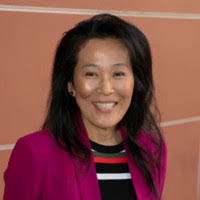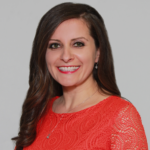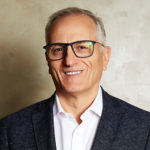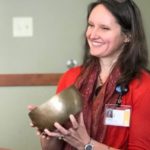Nurses, like other health care professionals, have been hearing the buzz about mindfulness. Technology corporations, like Google, are instituting mindfulness programs, as are health care and wellness-related workplaces. Lifestyle magazines like Oprah and Yoga Journal are covering the topic, but surprisingly, so are Harvard Business Review and other business publications.
Perhaps you’re wondering what the term actually means, and whether it’s been proven effective in treating patients and those who want to be proactive in warding off illness and disease.
In this article, nurses and mindfulness experts will explain their unique approaches and how they help patients with health challenges. You’ll learn about the evidence behind the practice, so you can comfortably introduce it to your patients. You might even want to incorporate it into your own work and personal life.
What is Mindfulness?
Simply, mindfulness means that you direct your mind to the present versus having it wander aimlessly. You practice an awareness of your thoughts, and a focus on the here and now, not the past or future.
The opposite state, “mindlessness,” is what happens when you drive home at the end of a 10-hour shift, suddenly arrive at your front door, and can’t remember how you get there.
Are You Interested in Trying Mindfulness for Yourself?
The mindfulness and health site, DrJud.com, offers a free online course for health care professionals. The seven-module video course answers common questions about the practice and the evidence supporting it.
Continuing medical education (CME) credits are available through Brown University.
To learn more about the course and sign up, visit www.drjud.com/health-care-provider-course.
Though mindfulness meditation is thousands of years old, with its roots in Buddhism, today’s mindfulness practices are often not spiritually centered. Scientifically-based mindfulness programs are meant to be used by patients of all faiths (or none).
That awareness may help boost patient emotional well-being and help strengthen their immune system. One example of the benefits of mindfulness, the Cleveland Clinic reports that 20 randomized trials reviewed in 2011 show improvement in overall mental health.
Mindfulness is a drug-free tool that can help optimize neural processing, boost immune system function, address the epidemic-level of chronic pain, reduce insomnia, and even caregiver burnout.
In new research, mindfulness shows promise in reducing the incidence of physical diseases or managing existing conditions. Examples are diabetes and hypertension. Mindfulness can also be an aid in breaking unhealthy habits, such as smoking, and averting the associated risk of disease.
One Nurse’s Research on Mindfulness and Hypertension
Eunjoo An, MSN, RN, a PhD candidate in nursing at UCLA, studied ways to reduce hypertension, which is the number one risk for stroke, she says. As a nurse, An knew that simply telling people what to do—eat right, exercise, etc.—wasn’t enough. She suspected that mindfulness training along with a health promotion program could have beneficial results.
Earlier research showed that mindfulness has a calming effect on the fight or flight response, leading to blood pressure and heart rate reduction, An says. “The difference in my research is that it’s looking at not only blood pressure but habits; most patients have difficulty changing diet and exercise,” she explains. “Mindfulness brings focused attention to body. During those times you’re more likely to say to yourself: ‘I should eat better,’ and then that translates to that behavior. No study has taken that to the next step.”
An used the UCLA mindful awareness program beginner’s course, which is not as extensive as some approaches, but more approachable than others, she says. The mindfulness group was told to practice at home. She hoped that the training would help calm patients and that reduced stress would translate to behavior change.
Her research was applied to hypertension in an independent living facility that is primarily African American. She was the instructor for the health promotion group, using the six-week program modules on a government website. Both groups received information about healthy diet and the importance of exercise.
The results? “The mindfulness group, with stage 1 hypertension, reduced their systemic blood pressure to normal range at the end of the 12-week study,” she says. While blood pressure did go down in both groups, “in the mindfulness group it dropped into the normal range whereas in the health promotion group it stayed in the high range.” Mindfulness practice was beneficial in helping patients to eat and exercise in such a way that their blood pressure dropped 40%.
To learn more, watch An’s three-minute presentation about her research on the benefits of mindfulness available on YouTube.
Beyond Mindfulness for In-Patient Care
The Urban Zen Integrative Therapy (UZIT) program brings mindfulness plus yoga, Reiki, essential oil therapy, and contemplative end-of-life care to patients and providers. Started in 2009 by fashion designer Donna Karan in New York, it soon expanded nationwide with the launch of the UZIT teacher training program.
“UZIT-trained therapists provide a variety of care, in a wide range of settings, to patients, staff, and caregivers, plus the community,” explains Menna Olvera Feder, UZIT acting program director.
Services can be accessed through a number of hospitals, rehab centers, senior-care and hospice facilities, as well as yoga studios offering drop-in stress-management class.
Research has been conducted at multiple facilities, including Beth Israel Medical Center in New York City and Wexner Heritage Village in Columbus, Ohio, showing significant health benefits. Patients experienced fewer symptoms of pain, anxiety, nausea, insomnia, constipation, and didn’t require as much medication for relief from those conditions.
When a UZIT-trained nurse “sees a patient isn’t breathing well, or is in pain, or is exhausted, they have what they need in their toolbox to address it,” says Olvera Feder. The UZIT protocol “adds a level of care to nursing that drew the nurse to be a nurse to begin with.”
The holistic program is used in health care environments with a diversity of patient populations. “We want to attract people of different cultures and those who are bilingual. We’re always looking for nurses who are Spanish-speaking or who speak Chinese,” says Olvera Feder.
Simple, clear terms are used to introduce the care modalities to patients and their families. For instance, “yoga,” is explained as “mindful movement to address respiration, digestion, and circulation,” Olvera Feder says. “Because when you’re in bed, you’re not doing downward dog.” Mindful movement in that case may mean that pillows aren’t stacked too high, and the patient is positioned in simple supported postures to bring them into a more comfortable state.
The UCLA Health has a number of UZIT trained health care professionals, among them is Anna Dermenchyan, RN, MSN, CCRN-K. An Armenian American, Dermenchyan was an ICU nurse before transitioning to a quality role in 2013, with the aim of improving patient care. She is also pursuing her PhD in nursing at UCLA School of Nursing.
“Urban Zen is meant for patients who feel pain and anxiety—that’s pretty much any patient in a hospital—they feel so much better after,” she says. One of the moving examples of UZIT’s effectiveness was when Dermenchyan sought to help a family say their final farewells to a brain-dead patient. “We provided Reiki and essential oils to them and a sad experience was made less painful,” she recalls.
Though always aware of stress in the health care workplace and how it affects nurses and patients, “I realize now how stressed everyone is, including physicians and administrators, and how vulnerable they are to fatigue and burnout,” she adds.
Mindfulness Class in Your Pocket
Not every organization has a mindfulness program available for patients, and not every patient has the money or time to attend formal training sessions. That’s where digital mindfulness apps come into play.
“We consider ourselves the leader in evidence-based, digital therapeutics for mental health,” says Mark Mitchnick, MD, CEO of MindSciences, Inc. “It’s pretty easy to put an app out in the health care space, especially in mental health, but do they have evidence behind them? We get grouped with some very scientific, rigorously researched” companies, and some that are not.
Currently the company offers three apps: Eat Right Now to address emotional eating, Unwinding Anxiety to relieve anxiety and stress, and Craving to Quit for smoking cessation. They are based on the work of Judson Brewer, MD, PhD, a leading mindfulness researcher, $11 million in funding from the National Institutes of Health (NIH), and input from thousands of users in clinical trials, and later as subscribers.
Many users first learn about this brand of apps because their health care provider recommends them. “It’s offered to individuals through organizations and insurance providers, such as Humana,” he explains. “We wanted to offer [mindfulness] as something scalable and very affordable—and today that’s an app.”
For example, MindSciences is “working with coal miners in Appalachia, using our smoking app in a pulmonary clinic,” says Mitchnick. “Folks are enrolled in a clinic but still smoke.” Using a hybrid model of delivery—digital app plus the participation of health care professionals—they aim to help patients kick the smoking habit.
Similarly, they’ve started working with bariatric surgery clinics to help patients avoid regaining weight lost after surgery. “We’re not a willpower-based system,” he says. “In the case of eating, you have to separate out ‘I’m feeling hungry’ from ‘I’m feeling anxiety,’ and find a more appropriate behavior for that.”
Interested individuals can independently download the app, try it out free for three days, and later subscribe. In the case of Craving to Quit, the program is $24.99 a month, which includes the mobile app training modules, an online support community, and weekly live expert video group coaching sessions. The program has been shown to be twice as effective as a leading smoking cessation treatment, and it’s backed by a limited money-back guarantee.
Mindful Yoga-Inspired Tools for Patients
Oregon Health & Science University (OHSU) in Portland, Oregon, offers a number of mindfulness programs to its patients and staff members. Kimberly Carson, MPH, C-IAYT, E-RYT, is a mindfulness educator and yoga therapist. She is considered a leader in the therapeutic use of mindful yoga for people with medical challenges.
Carson offers an ongoing drop-in class, Breath by Breath, as an introduction to mindfulness-based stress reduction methods. The class is free of charge to OHSU patients and any interested members of the community.
“Breath by Breath is a combination of mindfulness practices and yogic tools,” she explains, for cardiac, oncology, chronic pain, and other patients, plus their caregivers. “Sometimes people come once, sometimes a few times, or sometimes for years.” The class is held twice a week, for hour-long sessions, in conference rooms offered by participating departments.
Along with instruction in a variety of relaxation and mindfulness practices, Breath by Breath incorporates yoga-inspired adaptive movement, “We don’t take people to the floor,” explains Carson, “these movements are appropriate for most people—the postures are skillful to a medical or aging physiology.”
Group discussions and sharing make up an important component of the session. “At the beginning of the class, “I use what I call the ‘quickening question,’ which is totally spontaneous, such as ‘What inspired you today?’” she says. “The question helps give voice to people’s experience.”
She also facilitates Mindful Yoga for Chronic Pain, a five-week, drop-in series, “which is more asana heavy,” she explains. Gentle postures help patients develop mindful awareness of bodily sensations, thoughts, and emotions in this evidence-based intervention.
Beyond classes, Carson offers “bedside mindfulness” in the Bone Marrow Transplant Unit to address pain, agitation, insomnia, and existential distress. “I go in and lead patients through a mindfulness process,” she explains. “It quiets the nervous system, so they get relief right then. We do a body scan and breath awareness exercise. That’s the face-to-face introduction to the skill, to give them a taste of what’s available.” Later, patients can access more training modules on “the mindfulness channel” via OHSU’s digital education platform.
Mindfulness for Minority Communities
Jeffrey Proulx, PhD, is a Native American who has been studying mindfulness as a way to reduce psychological stress and improve physical health in underserved communities. A K99/R00 award from the NIH National Center for Complementary and Integrative Health is currently funding his contemplative-based program to reduce diabetes in Native communities. He has also done culturally based mindfulness research with other ethnic minority communities.
Proulx believes that psychological stress needs to be viewed in a wider context that includes historical oppression. “They wanted to wipe Native Americans off the face of the earth, and African Americans were enslaved,” he explains. “So, for these populations, daily stress is compounded by historical stressors.” But instead of focusing on cultural trauma and the associated poor health behaviors, he works with communities to explore their resiliency and strength.
Mindfulness-Based Stress Reduction [MBSR] is the landmark evidence-based program developed by Jon Kabat-Zinn at the University of Massachusetts Medical Center in 1979. Many health care mindfulness programs and health apps are based on this intensive, eight-week training series. Proulx has facilitated these classes for patients and health care providers at OHSU, as has Carson.
“But MBSR isn’t really geared to address cultural trauma, intergenerational trauma, people getting sicker from generation to generation,” he explains. “I’m approaching it from another way. The bigger, overall issue is how people carry on.”
One way Proulx makes sure his offering is culturally competent is by using the term “stress reduction” rather than “mindfulness.” That only goes so far, he warns: “You can call it different things to sand down the edges,” but it doesn’t change the basic shape, and what he’s trying to create “is a program to get at stress in your community, not just the upper class white community.”
The development process is long for his years-long studies in these communities who may be suspicious of him or medical professionals generally. To head off prejudice, he enlists the endorsement of community leaders (e.g., the tribal council or church pastor) and forms a small advisory group for guidance and assistance.
Proulx aims to create a safe, open, and accepting environment among community members. “You do that by learning about the history of the community, the culture, and becoming part of the neighborhood,” he says. “It’s an effort to develop trust, show trustworthiness, and embody trustworthiness.”
Their own culture then informs how these involved community members experience his mindfulness and stress reduction training. “‘Oh, it’s like Proverbs,’ I often hear,” says Proulx. “Or ‘It’s like Christian charity and compassion.’”
Underserved populations can also be a source of future trainers and greater diversity in the mindfulness field. “I encourage people in those communities to become teachers,” he explains. “Brown University is paying for that training.”
- Resumes, LinkedIn, and HR Portal Profiles, Oh My! - May 22, 2020
- Weight Management for Nurses: The Why’s and How’s of Losing or Maintaining Weight - February 18, 2020
- Mindfulness and Wellness Programs for Patients - October 14, 2019









